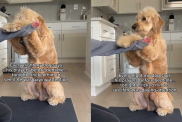No one would think of putting a shock collar on a canary, squirting lemon juice into a baby’s mouth or beating a husband with a rolled-up newspaper and having his vocal cords cut for “singing” in the shower. However, people think nothing of doing all of these and more to barking dogs. Barking poses particular problems because owners are consistently inconsistent. Sometimes the dog is allowed to bark. Sometimes it is encouraged to bark, yet other times it is severely punished for barking. It is all so confusing and stressful for the poor dog. No wonder the dog lets rip when the owner is away from home.
If your dog barks when you are away from home, for goodness sake do not confine it outdoors. In fact, outdoor confinement likely precipitated the problem in the first place. Sound carries. If confined outside, your dog will more easily hear outside disturbances, and your neighbors will be more easily disturbed by the dog’s barking. Until the barking problem has been resolved, restrict barking by confining your dog indoors, preferably to a single room (to reduce activity), away from the street (to reduce the effect of outside disturbances) and on the opposite side of the house from complaining neighbors (to reduce complaints). Draw the curtains in the confinement area and otherwise insulate for sound. Leave a radio playing fairly loudly to reassure the dog and to provide white noise, which will help muffle sounds from outdoors and disguise the dog’s barking.
When at home, it is easier and less confusing to start with a single rule: barking is OK until the dog is instructed to “Shush,” whereupon it is expected to be quiet for a specified time — say one or two minutes — after which, most dogs will have forgotten what sparked them off in the first place. The first step in training your dog to decrease the frequency of barking is to teach it to bark on command. This may sound a little silly; however, it is important to realize that barking is a temporal problem, i.e., the dog barks excessively, or it barks at inappropriate times. By training your dog to bark on command, at least you establish partial temporal control over the behavior. Also, once barking is under stimulus control, it becomes possible to instruct your dog to bark at times when it may not feel like barking, which greatly facilitates teaching the more important “Shush” command.
Training your dog to bark on command
Select a stimulus which prompts your dog to bark, e.g., the doorbell. Station an accomplice outside the front door. Instruct your dog to “Alert” or “Defend” (more impressive commands than “Sing” or “Speak”), which is the cue for your accomplice to ring the door bell, which in turn prompts your dog to bark. Your dog will quickly learn to anticipate the sound of the doorbell following your command and after just half a dozen or so repetitions, the command “Defend” will be sufficient to prompt your dog to bark. This is the type of training exercise that may give a guard dog an insecurity complex. “How on earth does the owner always know when the doorbell is about to ring? I’m going to lose my job unless I bark when the owner says Defend.”
Training your dog to shush
At a time when your dog has no cause to give voice, instruct it to bark and profusely praise it for doing so. This practice alone pleasantly surprises most dogs, especially if you join in and sing along. Then, instruct your dog to “Shush,” and waggle a food treat in front of its nose. Once your dog stops barking to sniff (it is impossible to sniff and bark simultaneously), offer the treat and gently praise your dog for eating quietly. Talking in whispers will encourage your dog to listen, and if it listens, it will be unlikely to bark, otherwise it would not be able to hear what it is listening to. Using the treat as a lure/hand signal to entice your dog to sit and/or lie down will also help the dog settle down and shush. After only a couple of seconds of silence, tell the dog to bark again – a second pleasant surprise for the dog. No matter how difficult it was getting the dog to shut up the first time, it will be much easier the second time. Then, tell it to bark again – “Good dog Rover, good woofs” and then instruct it to “Shush” — “Good dog Rover, goooood shhhhushhhh.” Repeatedly turn the dog ‘on’ and ‘off,’ and praise and reward the dog both for barking and for being quiet. Fait accompli!
Now, your trained dog may be allowed to be a dog and bark until instructed to “Shush.” You may now begin to modify your dog’s barking sprees by teaching specific rules about barking: 1) in response to which stimuli the dog must bark, e.g., strangers, doorbell, etc., 2) to which stimuli it is allowed to bark (a little), e.g., a cat in the yard (come on, let’s be fair!), 3) for how long it is allowed to bark in each instance (e.g., at least 10 woofs for someone at the front door, but only a maximum of three to four woofs for a neighborhood cat or dog), and 4) to which stimuli the dog is not allowed to give voice, e.g., an oak leaf falling three blocks away — hardly a world-shattering event that needs to be heralded by several hundred woofs!









